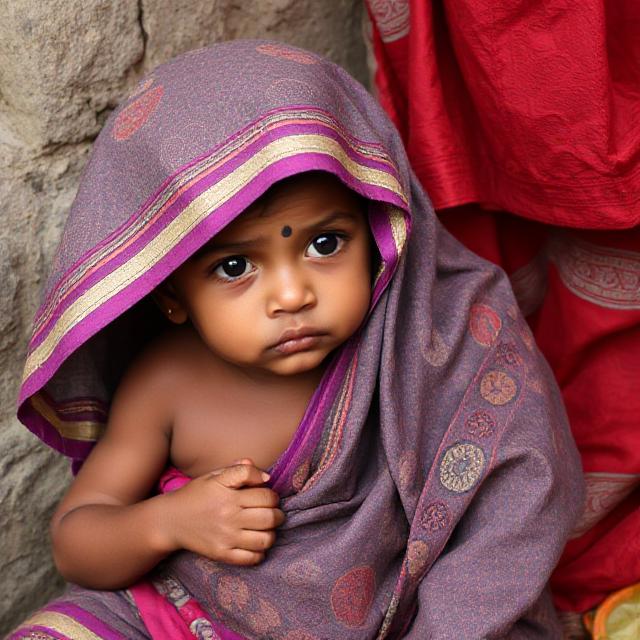India’s Hidden Hunger: Malnutrition Hits 37% of Children – A National Crisis Demanding Urgent Action
The specter of malnutrition continues to haunt India’s children, casting a long shadow over the nation’s future. Recent revelations in the Rajya Sabha have exposed a disturbing reality: nearly 37.07% of children across India are grappling with malnutrition, with stunted growth being the most prevalent manifestation. This staggering statistic means that more than one in three children in the world’s most populous nation are growing up without adequate nutrition, compromising not just their physical development but their cognitive potential and future prospects.
The Magnitude of India’s Child Malnutrition Crisis
Child malnutrition in India represents one of the most pressing public health challenges of our time. The latest parliamentary data paints a grim picture where millions of children are trapped in a vicious cycle of undernourishment, affecting their ability to reach their full potential. When we examine the malnutrition statistics India presents, the numbers are nothing short of alarming – 37.07% of children suffering from various forms of nutritional deficiency represents a humanitarian crisis hiding in plain sight.
The concept of stunted growth goes beyond mere physical appearance. It represents a fundamental failure in providing children with the essential nutrients required during their most critical developmental years. These undernourished children face lifelong consequences that extend far beyond their childhood, impacting their educational achievements, economic productivity, and overall quality of life.
Understanding the Different Faces of Malnutrition
Malnutrition among Indian children manifests in multiple forms, each carrying its own set of devastating consequences:
Stunting: The most prevalent form affecting Indian children, stunting occurs when chronic malnutrition leads to impaired growth and development. Children suffering from stunted growth are significantly shorter than their age-appropriate height standards, indicating prolonged nutritional stress during crucial developmental periods.
Wasting: This acute form of malnutrition results in children being significantly underweight for their height, indicating recent and severe weight loss or failure to gain weight. Wasting often signals immediate health dangers and requires urgent intervention.
Underweight: A composite indicator that reflects both chronic and acute malnutrition, underweight children fall below normal weight-for-age standards, indicating overall nutritional inadequacy.
Micronutrient Deficiency: Often called “hidden hunger,” this involves deficiencies in essential vitamins and minerals like iron, zinc, vitamin A, and folate, leading to impaired immune function, cognitive development issues, and increased susceptibility to diseases.
The Root Causes Behind India’s Nutritional Challenge
The persistence of child malnutrition in India stems from a complex web of interconnected factors that span socioeconomic, cultural, and systemic dimensions:
Poverty and Food Insecurity: Economic constraints remain the primary driver of malnutrition, with millions of families unable to afford nutritious foods consistently. The lack of purchasing power forces families to rely on cheaper, calorie-dense but nutrient-poor foods.
Limited Access to Healthcare: Inadequate healthcare infrastructure, particularly in rural areas, means that nutritional interventions, growth monitoring, and early intervention programs often don’t reach the children who need them most.
Poor Sanitation and Hygiene: The lack of proper sanitation facilities leads to frequent infections and diseases that compromise nutrient absorption and increase nutritional requirements, creating a vicious cycle of malnutrition and illness.
Educational Gaps: Limited awareness about proper nutrition, especially among mothers and caregivers, results in suboptimal feeding practices during critical periods like the first 1,000 days of a child’s life.
Agricultural Challenges: Despite being an agricultural economy, India struggles with producing and distributing diverse, nutrient-rich foods, often prioritizing quantity over nutritional quality.
Tamil Nadu: A Beacon of Hope in Nutritional Interventions
While the national picture appears daunting, Tamil Nadu emerges as a remarkable success story in combating child malnutrition. With a malnutrition rate of just 14.23% among children – less than half the national average – the state demonstrates that effective nutritional interventions can yield transformative results.
The Tamil Nadu government’s comprehensive approach to addressing malnutrition serves as a model for other states. Their strategy encompasses multiple dimensions of child welfare, creating a robust ecosystem that supports optimal child development from birth through adolescence.
Strategic Healthcare Investment
Tamil Nadu’s success begins with its substantial healthcare investment, focusing on preventive care and early intervention. The state has established a comprehensive network of primary healthcare centers that prioritize maternal and child health services. These facilities are equipped to identify nutritional deficiencies early and provide appropriate interventions before they become severe.
The state’s healthcare system emphasizes regular growth monitoring, immunization programs, and nutritional counseling for mothers and caregivers. This proactive approach ensures that potential nutritional problems are identified and addressed before they manifest as severe malnutrition or stunted growth.
Revolutionary Midday Meal Programs
The nutritious midday meals program in Tamil Nadu represents one of the most successful nutritional interventions in the country. Going beyond the basic requirements of the national scheme, Tamil Nadu has enhanced its program to provide more diverse, locally-sourced, and nutritionally balanced meals.
The state’s midday meal scheme includes:
- Fortified rice with essential micronutrients
- Protein-rich legumes and vegetables sourced from local farmers
- Micronutrient supplementation through various food items
- Quality control measures ensuring food safety and nutritional adequacy
- Community participation in meal planning and preparation
This comprehensive approach ensures that children receive at least one nutritious meal daily, significantly contributing to their overall nutritional status while also promoting school attendance and retention.
Comprehensive Maternal Support Systems
Recognizing that child nutrition begins before birth, Tamil Nadu has implemented extensive maternal support programs that address nutrition during pregnancy and lactation. These programs include:
Antenatal Nutrition Programs: Pregnant women receive regular nutritional counseling, iron and folic acid supplementation, and access to nutritious food supplements through various government schemes.
Breastfeeding Promotion: The state actively promotes exclusive breastfeeding for the first six months and continued breastfeeding with appropriate complementary feeding thereafter.
Postnatal Support: New mothers receive ongoing support to ensure proper infant feeding practices and early identification of nutritional concerns.
Community-Level Outreach Programs
Tamil Nadu’s success in reducing child malnutrition is largely attributed to its robust community level outreach programs that bring nutritional interventions directly to families’ doorsteps. These programs involve:
Anganwadi Workers: Trained community workers who provide direct nutritional counseling, growth monitoring, and early childhood development services at the grassroots level.
Self-Help Group Networks: Women’s self-help groups are mobilized to promote nutritional awareness and support implementation of various nutritional programs.
Community Health Volunteers: Local volunteers are trained to identify signs of malnutrition and connect families with appropriate services and support.
Integrated Child Development Services: A comprehensive approach that combines nutrition, healthcare, and early childhood education services at the community level.
The Economic and Social Impact of Malnutrition
The consequences of child malnutrition extend far beyond individual health outcomes, creating ripple effects that impact economic development and social progress:
Educational Outcomes: Malnourished children often struggle with cognitive development, leading to poor academic performance, higher dropout rates, and reduced educational attainment. This educational deficit perpetuates cycles of poverty and limits human capital development.
Economic Productivity: Adults who experienced childhood malnutrition often have reduced physical capacity, cognitive abilities, and earning potential, contributing to decreased economic productivity at both individual and national levels.
Healthcare Costs: Malnutrition increases susceptibility to various diseases and infections, leading to higher healthcare expenditures and reduced quality of life throughout the lifespan.
Intergenerational Transmission: Malnourished girls are more likely to become malnourished mothers, passing nutritional deficiencies to the next generation and perpetuating the cycle of malnutrition.
Successful Interventions and Best Practices
Drawing from Tamil Nadu’s success and international best practices, several key interventions have proven effective in addressing child malnutrition:
Early Intervention Programs: Focusing on the first 1,000 days of life (from conception to age two) when nutritional interventions have the greatest impact on long-term development outcomes.
Integrated Approaches: Combining nutrition-specific interventions (like feeding programs) with nutrition-sensitive interventions (like improved sanitation, healthcare, and education) for maximum impact.
Community Engagement: Involving communities in designing, implementing, and monitoring nutritional programs ensures cultural appropriateness and sustainability.
Multi-sectoral Coordination: Effective nutrition programs require coordination across health, education, agriculture, and social welfare sectors to address the multiple determinants of malnutrition.
Data-Driven Decision Making: Regular monitoring and evaluation of nutrition programs enables continuous improvement and evidence-based policy adjustments.
Technology and Innovation in Nutrition Programs
Modern technology is increasingly being leveraged to enhance the effectiveness of nutritional interventions:
Digital Health Records: Electronic tracking systems help monitor child growth patterns and identify children at risk of malnutrition for timely intervention.
Mobile Health Applications: Smartphone apps provide nutrition education, feeding guidance, and connect families with healthcare services.
Supply Chain Management: Technology-enabled systems ensure efficient distribution of nutritious foods and supplements to target populations.
Data Analytics: Advanced analytics help identify patterns and predict nutritional risks, enabling proactive interventions.
Challenges and Barriers to Progress
Despite success stories like Tamil Nadu, several challenges continue to impede progress in addressing child malnutrition across India:
Resource Constraints: Limited financial resources often restrict the scale and quality of nutritional interventions, particularly in resource-poor states.
Implementation Gaps: Even well-designed programs often face implementation challenges due to inadequate infrastructure, human resources, or administrative capacity.
Cultural and Social Barriers: Deep-rooted cultural practices and social norms sometimes conflict with optimal nutrition practices, requiring sensitive and sustained behavior change efforts.
Monitoring and Accountability: Weak monitoring systems and limited accountability mechanisms often allow nutritional problems to persist without appropriate responses.
Coordination Challenges: Poor coordination between different sectors and levels of government can lead to fragmented and ineffective interventions.
The Path Forward: Scaling Success Across India
To replicate Tamil Nadu’s success nationwide, India needs a comprehensive strategy that addresses both immediate nutritional needs and underlying determinants of malnutrition:
Policy Integration: Developing integrated policies that address nutrition across multiple sectors including health, education, agriculture, and social protection.
Capacity Building: Investing in training and capacity building for healthcare workers, teachers, and community volunteers to effectively implement nutritional interventions.
Infrastructure Development: Strengthening healthcare infrastructure, particularly in rural and underserved areas, to ensure universal access to nutrition services.
Research and Innovation: Promoting research into culturally appropriate and cost-effective nutritional interventions suitable for India’s diverse contexts.
Public-Private Partnerships: Leveraging private sector expertise and resources to complement government efforts in addressing malnutrition.
Conclusion: A Call for Urgent Action
The revelation that 37% of Indian children suffer from malnutrition represents both a moral imperative and a development emergency. While the challenge is enormous, Tamil Nadu’s success demonstrates that significant progress is possible with political commitment, strategic investments, and comprehensive interventions.
The cost of inaction is far too high – not just in terms of individual suffering but also in terms of lost economic potential and social development. Every malnourished child represents a future diminished, a potential unrealized, and a society that has failed in its most fundamental responsibility.
The path forward requires sustained commitment from government, civil society, private sector, and communities working together toward a common goal: ensuring that every Indian child has access to adequate nutrition for optimal growth and development. Only through such collective action can India hope to break the cycle of malnutrition and unlock the full potential of its greatest resource – its children.
The success of Tamil Nadu proves that change is possible. Now, it’s time to scale these successes across the nation, transforming the lives of millions of children and building a healthier, more prosperous future for India. The question is not whether we can address child malnutrition, but whether we have the collective will to act with the urgency this crisis demands.











